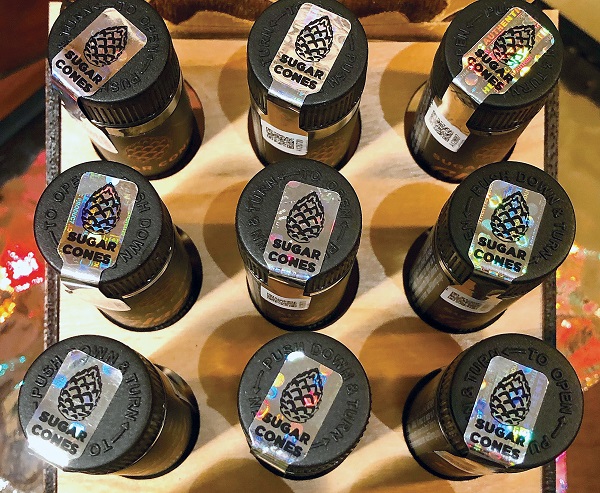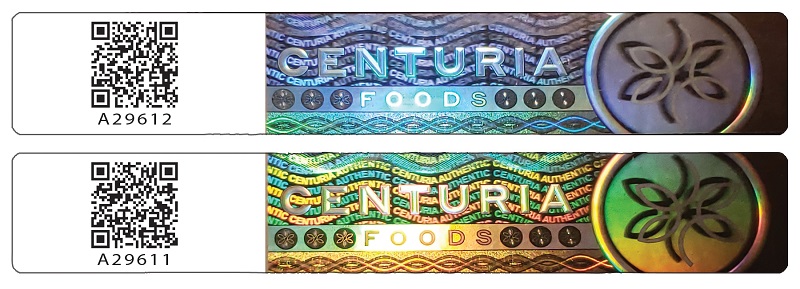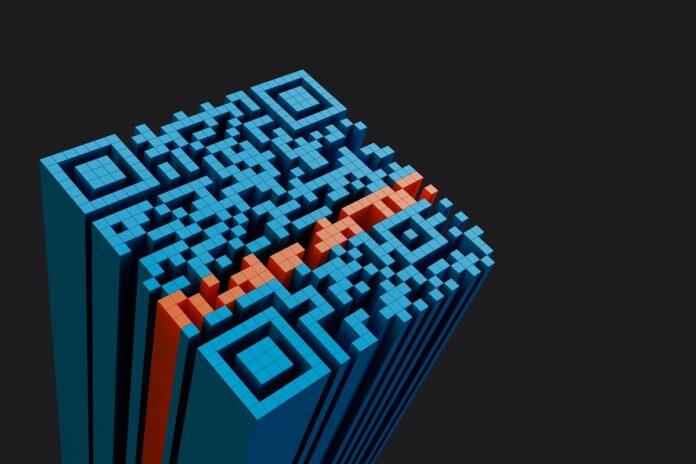Worldwide in 2017, legitimate brands lost U.S. $1.2 trillion to forged merchandise, according to the Global Brand Counterfeiting Report 2018–2020. Final figures aren’t yet available for 2020, but experts estimate brands lost about $2 trillion. Online and offline, counterfeiting touches every product category from defense equipment to consumer goods, siphoning revenue away from legitimate businesses and into the black market. The problem is of particular concern for the cannabis industry, where—despite expanding legalization—the black market accounts for up to 80 percent of sales in some states.
Counterfeiters harm more than just revenues. Untested, haphazardly manufactured goods damage the reputation of the brands they impersonate. They injure consumers who use them, and they feed anti-legalization forces’ false narrative about “demon weed.” But suppressing counterfeiters is not an easy task, often amounting to little more than playing whack-a-mole with a hydra: Stomp one fraudster here, and five more pop up over there to take their place.
Enter Peter Scheir, a silversmith who almost accidentally found himself in the middle of a technological revolution that could help brands and consumers alike feel more confident about product legitimacy. Scheir’s company, AuthentiBrand Inc., pairs holograms and a proprietary software platform to provide consumers and retailers with real-time product authentication and brands with security and surprisingly compelling marketing opportunities.
Scheir’s holograms are not the laser-etched-glass curios, jewelry, and pop-art that took the world by storm in the 1980s; nor are they the ridged-surface, “dancing-image” illusions seen on bookmarks, postcards, and other tchotchkes. While fun, those novelties are almost an insult to the technology for which Dennis Gabor won the 1971 Nobel Prize for physics. Scheir became acquainted with holography when asked to craft jewelry settings for fellow artisans who worked with the medium. He segued from there into creating his own mind-bending 3D holographic illusions, some of which hung in Haight-Ashbury head shops and along Pier 3 in San Francisco, at South Street Seaport in New York City, in Boston’s Faneuil Hall, and in hundreds of pop-up shops inside science museums and specialty stores.
With interest in the art form surging in the late 1980s, Scheir founded HoloBank, the world’s first customizable stock image hologram repository, opening a vast market of affordable, short-run, fast-turnaround uses for the attention-getting images. That led to contracts to design artistic holograms for a veritable laundry list of entities including Pfizer, IBM, FedEx, Hewlett Packard, DuPont, Burton Snowboards, the U.S. Army, Bausch and Lomb, and Schick. Currently, his work appears on Speedo’s Holo-Wonder swim goggles.

What most fascinates Scheir, though, are the almost limitless security applications for small, 3D holograms. Most people are familiar with security holography from glancing at their credit cards and driver’s licenses, but the images—many crafted by AuthentiBrand—also safeguard access badges, passports, certificates of authenticity for sports memorabilia and other collectibles, tamper-proof packaging, and other high-value or security-critical items.
And that’s what brought Scheir into cannabis. “Adding tamper-evident security holograms to Flav’s vape carts was my first large account in the cannabis industry, and now our holograms grace millions of cannabis packages,” he said.
Cannabis packaging is tricky business. Packages must meet state regulatory requirements while at the same time maintaining a brand’s aesthetic. As with any other highly regulated product, inventory control and tamper-evidence are paramount. All of those things can be accomplished with good holograms, Scheir said. “Often companies miss the importance [of using a high-quality holographic image] and use a cheap overseas twinkly pattern that’s incorrectly labeled a hologram,” he explained. The holograms AuthentiBrand produces are cutting-edge, with overt (visible to the unaided eye) and covert (viewable only with lenses, lasers, or other instruments) elements. AuthentiBrand’s holograms “are extremely difficult, if not impossible, for any other lab to create,” Scheir said.
AuthentiBrand’s custom holographic labels also are designed to reduce intellectual property theft and differentiate real from fake merchandise. “You can’t stop counterfeiting, but you can put something on your package that is nearly impossible to duplicate and provides an easy visual way to identify the legitimacy of your product,” he said. “Something that shows regulators, as well as your supply chain and customers, they are buying the real thing. Unfortunately, companies often wait until it’s too late and counterfeit products already have infringed on their brand, eating into profits and tarnishing their reputation.
“When cannabis is finally made federally legal, brands will face new regulations for authentication, tracking, and tamper-evident labeling,” he continued. “Holograms already are globally recognized as the regulatory standard for visual authentication on many official identification documents such as passports and state ID cards, so go above and beyond now. Be prepared.”

Brand managers sometimes assume holographic labels must be purchased in high volume at a premium price. That’s a myth Scheir would like to dispel. “AuthentiBrand—under its line names HoloShield® and QR Manager®—offers as few as 500 customized and QR-coded hologram labels delivered as quickly as the next day,” he said. “We develop affordable, comprehensive strategies for seed-to-sale tracking, authentication, marketing, and promotions. We inventory hundreds of thousands of proprietary holograms and offer fast turnaround times on customized orders, while scaling up quickly for high-volume and fully custom projects.”
Scheir developed the second half of AuthentiBrand’s system—the part that makes it revolutionary—in 2017. Patent-pending QR Manager allows users to create and use unique, serialized QR codes for multiple purposes, including inventory tracking and authentication. The system also facilitates micro-targeted marketing and consumer interaction and collects data as desired. QR Manager works with or without AuthentiBrand’s holograms.
“Although I still believe the combined product is by far the best way to go, if you want to create your own [QR] codes directly on the package or you just want your printer or co-packer to drop one on the label you’re already making, you can use all the power of our QR Manager without anything else,” Scheir said. “The dynamic codes can even be white-labeled to your brand, and you can print them yourself.”
Invented in Japan in the mid-1990s, QR (quick response) codes have been common in Asia and Europe for more than a decade. Numerous U.S. states now require QR codes on cannabis packages. California’s Bureau of Cannabis Control has proposed requiring dispensaries to display a QR code that, when scanned, provides proof of license. Distributors and retail delivery drivers also would be required to carry a QR code certificate while transporting products. A growing number of states have adopted packaging regulations requiring a QR code on all CBD products; scanning the code must display certified lab-testing results (often called certificates of analysis or COAs). With a single label, QR Manager can help multistate operators comply with such regulations in all states. Even in states where regulations don’t mandate QR-code-activated COAs, consumers and retailers are beginning to demand easy, instant access to product information not printed on the package—and clever brand managers can use people’s desire for convenience as a subtle marketing pathway.
“QR Manager requires no special app,” Scheir said. “Customers can scan the QR from almost any mobile device. Instantly, you’ve drawn them from the package into their familiar digital world, where you can learn their desires and direct them to helpful information.”
Try out the QR Manager Yourself Scan (twice) either of the QR Codes below to see it in action.

QR Manager connects the brand to its customers even after the sale. “Brands can log in to their own unique QR Manager portal, where they can direct at will their QR codes in ‘batches,’” Scheir said. “Further, we offer brands the ability to create branded landing pages simply and extremely quickly, directly on our platform, then upload their own marketing materials and schedule promotional campaigns with QR Manager’s easy-to-use applications. The system is infinitely scalable, cost effective, and easy to use.”
Other system features and capabilities include:
- Users need not know the URL to which they want to direct a code. Codes may be printed, then redirected as needed or desired.
- Individual codes within a set can be directed to different landing pages based on how many times the code was scanned, without affecting the rest of the project batch. Thus, if one code is counterfeited, evidence quickly will appear.
- Project batches easily can be split up and redirected for any reason, such as a box of product goes missing, an employee goes rogue, or to direct consumers to individual product pages long after the larger batch was sent to the brand’s homepage.Project batches can be directed based on time frame. For instance, scans performed after an expiry date take the user to a page explaining the expiration. Brand managers are made aware of scans after the expiry date.
- Project batches or parts of project batches can be directed to a promotional page for a certain period of time during which some codes within the batch will be declared “winners” and directed to a special page. When the promotion ends, all codes return to normal.
Since each QR code is unique (as opposed to using one code to label numerous items), marketing can be targeted at a single sale or a group of consumers using data gathered with each project batch.
“It’s really one of the first times in history that a brand has a direct connection to their end user without a separate public relations advertising campaign,” Scheir said. “With QR Manager, uses are limited only by your imagination.”












